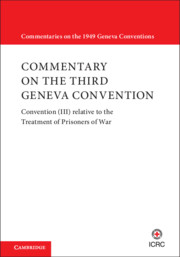 Commentary on the Third Geneva Convention
Commentary on the Third Geneva Convention Book contents
- Commentary on the Third Geneva Convention
- International Committee of the Red Cross
- Copyright page
- Contents
- Foreword by Peter Maurer
- Acknowledgements
- Abbreviations
- Introduction
- Preamble
- Part I General Provisions
- Part II General Protection of Prisoners of War
- Part III Captivity
- Part IV Termination of Captivity
- Part V Information Bureaux and Relief Societies for Prisoners of War
- Part VI Execution of the Convention
- Book part
- Sources
- Index
- References
Article 91 - Successful Escape
from II - Disciplinary Sanctions
Published online by Cambridge University Press: 21 August 2021
- Commentary on the Third Geneva Convention
- International Committee of the Red Cross
- Copyright page
- Contents
- Foreword by Peter Maurer
- Acknowledgements
- Abbreviations
- Introduction
- Preamble
- Part I General Provisions
- Part II General Protection of Prisoners of War
- Part III Captivity
- Part IV Termination of Captivity
- Part V Information Bureaux and Relief Societies for Prisoners of War
- Part VI Execution of the Convention
- Book part
- Sources
- Index
- References
Summary
Escape gives rise to a dilemma between two contrasting ideas. Thefirst is that attempts to escape may be viewed as a demonstration ofpatriotism and of the most honourable intentions, and not as acrime. According to this precept, prisoners of war have a right, amoral duty, and sometimes, under the law of the Power on which theydepend, even a legal obligation to escape. The second idea is thatan attempt to escape is a punishable breach of discipline vis-à-visthe Detaining Power, which it is under a strong obligation toprevent. These contrasting ideas have been described as the ‘paradoxof escape’, which is at the core of the legal framework onprisoner-of-war escapes.
- Type
- Chapter
- Information
- Commentary on the Third Geneva ConventionConvention (III) relative to the Treatment of Prisoners of War, pp. 1375 - 1385Publisher: Cambridge University PressPrint publication year: 2021
